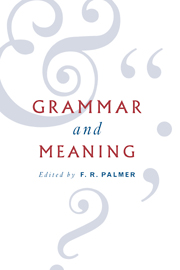Book contents
- Frontmatter
- Contents
- List of contributors
- Foreword
- 1 Polysemous relations
- 2 Fields, networks and vectors
- 3 Syntax, semantics, pragmatics
- 4 Natural-language interpretation as labelled natural deduction
- 5 Three levels of meaning
- 6 Does spoken language have sentences?
- 7 Grammaticalisation and social structure: non-standard conjunction-formation in East Anglian English
- 8 German Perfekt and Präteritum: speculations on meaning and interpretation
- 9 The possessed
- 10 Complement clauses and complementation strategies
- 11 Grammar and meaning
- John Lyons: publications
- Index
3 - Syntax, semantics, pragmatics
Published online by Cambridge University Press: 30 January 2010
- Frontmatter
- Contents
- List of contributors
- Foreword
- 1 Polysemous relations
- 2 Fields, networks and vectors
- 3 Syntax, semantics, pragmatics
- 4 Natural-language interpretation as labelled natural deduction
- 5 Three levels of meaning
- 6 Does spoken language have sentences?
- 7 Grammaticalisation and social structure: non-standard conjunction-formation in East Anglian English
- 8 German Perfekt and Präteritum: speculations on meaning and interpretation
- 9 The possessed
- 10 Complement clauses and complementation strategies
- 11 Grammar and meaning
- John Lyons: publications
- Index
Summary
The fields referred to in the title of this chapter have become part of the institutional structure of linguistics. Each has scholars who specialise in it, and advertisements for teaching posts will often specify expertise in one or more of them. The divisions between them are also reflected in the organisation of lecture courses and exam papers. But are they just an institutional convenience? Or do these terms refer to real distinctions?
Let us begin by reminding ourselves of their history. The term ‘syntax’ is far older than the others, and has been used by most linguists throughout this century to refer to a branch of grammar concerned with the construction of sentences. Since the 1940s that has often been taken to exclude the study of meaning; but it does not have to be so interpreted. For Bloomfield, for example, semantics was a ‘phase’ of linguistics whose task was to relate formal features to features of ‘distinctive’ or ‘linguistic meaning’ (1935: 74, 138,141). But just as the units of Bloomfield's lexicon associated forms with meanings, so too did his units of grammar. Therefore their study was not separate from semantics, but part of it. Semantics as Bloomfield defined it was ‘ordinarily divided’ into grammar and lexicon (138), or ‘equivalent to’ the investigation of these fields (513, notes to section 5.1).
- Type
- Chapter
- Information
- Grammar and MeaningEssays in Honour of Sir John Lyons, pp. 48 - 60Publisher: Cambridge University PressPrint publication year: 1995
- 2
- Cited by

